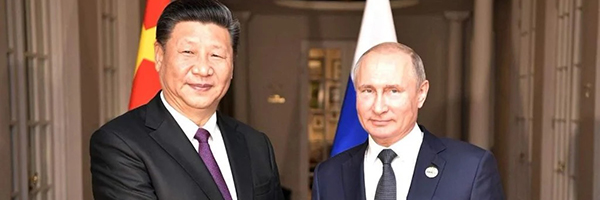US-NATO Intent to Damage Russia-China Relations?
Some analysts have been claiming that Beijing is “breaking” with Moscow over the issue of Ukraine. In June this year the Chinese government conducted military drills in its northeastern border with Russia, while Moscow was mostly preoccupied with its own military operations in Ukraine. This event led some Western observers to speculate, albeit there is no evidence, that this could be a sign China has unfinished business in that border area.
The 1858 Treaty of Aigun established much of the modern border between Manchuria (Northeast China) and the Russian Far East. From a Chinese Perspective, especially since the rise of Chinese nationalism in the 1920, it was an “unequal treaty”, having been signed, as it was, when the Chinese Empire was a weakened state: it gave the neighboring Russian Empire over 600,000 square km from Manchuria.
As a legacy of the 19th and the 20th century, the Eurasian great powers often have border disagreements. Japan historically has variances with Russia over the Kuril islands, for example, as it has with its other “neighbors” China and South Korea as well. India and China notoriously have theirs too, which, by the way, has not stopped both of them from cooperating with one another, as is exemplified by the fact that they have recently withdrawn their troops from the disputed Ladakh region’s border area, thus moving one step towards the Asian century.
Indian-Chinese cooperation in fact is particularly remarkable, considering the former’s position within the QUAD, which is seen by many as Western anti-Chinese “new NATO”. Yet even amid serious bilateral disagreements, Eurasian states have shown that there is plenty of room for cooperation on a number of levels, and, in the same way, New Delhi has also maintained close ties with Moscow, while getting closer to Washington. The same logic must apply to Sino-Russian cooperation, notwithstanding their differences over the Northeast China-Russian Far East border region.
In 1969, in this very region, near the Amur river, there was a seven-month undeclared military conflict between China and the Soviet Union, shortly after the so-called Sino-Soviet split. After the conflict, the United States sought to strengthen ties with Beijing by secretly sending Henry Kissinger to China for his now famous 1971 meeting with Zhou Enlai, which in turn paved the way for then US President Richard Nixon visiting China and meeting with Mao Zedong the next year. And yet even with the Sino-Soviet split, the two states managed to stabilize their relations in the late seventies.
In the more recent past, on 21 July 2008, then Chinese Foreign Minister Yang Jiechi and his Russian counterpart, Sergei Lavrov, signed in Beijing an additional Sino-Russian Border Line Agreement, thus marking the acceptance of the eastern portion of the Chinese-Russian border’s demarcation.
On February 4, in Beijing, a joint statement by Russian President Vladimir Putin and his Chinese counterpart Xi Jinping famously declared that the friendship between the two states “has no limits”. Such a statement, somewhat hyperbolic as it may be, in any case, from an American perspective, is quite terrifying as it poses a direct challenge to Washington’s ambitions of maintaining unipolarity.
No friendship is really absolute, but the truth is that Chinese-Russian relations have entered a new era, and Beiing’s trade and investment in the Russian Far East, such as in the Vladivostok Port – Trans-Siberian Railway, must also be seen in this context, as the Belt and Road Initiative investments into the Russian Federation go on. Chris Devonshire-Ellis, publisher of Asia Briefing, writes that both powers view the Heihe-Blagoveshchensk border cities (which sit opposite each other on the Amur River opposing banks) as key strategic development hubs in an access point to the Trans-Siberian railway. That being so, maintaining peace at the border is in the best interests of both Moscow and Beijing, contrary to the wishful thinking of some Western analysts.
In any case, much has been done, in the US-led West, in terms of PR and diplomacy to try to “counter” the “no-limits” friendship concept, and to promote and explore Russian-Chinese points of contention. Thus, in the same way Washington inflates India’s Prime Minister Narendra Modi’s comments to Putin on Ukraine, it tries to do the same pertaining to Moscow and Beijing and it will certainly try to explore the issue of Manchuria.
Although, under American influence, Japan has changed its stance on Russia partly over the aforementioned Kuril islands, this of course does not in any way mean that China would behave similarly. Chinese-Russian Eurasian strategic interests converge very deeply and both states have sophisticated diplomacy apparatuses to bilaterally pursue collaboration, bilateral disputes apart, while also employing the framework of forums such as the SCO and the BRICS group to coordinate their perspectives together so as to maximize benefits for all.
*
This article was originally published on InfoBrics.
Uriel Araujo is a researcher with a focus on international and ethnic conflicts.

 Uriel Araujo, Global Research, September 24, 2022 — Reviving the Aigun Treaty Border Issue? Although Tokyo changed its stance on Russia partly over the Kuril islands dispute, it is unlikely that China would raise the border issue.
Uriel Araujo, Global Research, September 24, 2022 — Reviving the Aigun Treaty Border Issue? Although Tokyo changed its stance on Russia partly over the Kuril islands dispute, it is unlikely that China would raise the border issue.